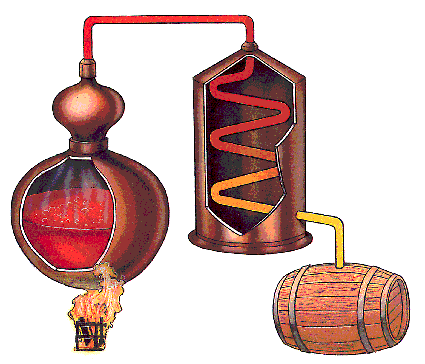From the arabic al-inbīq (paunchy bottle or container), the distillation device consisted of a boiler connected by a tube with a cooling coil from which the distillate is collected.
There are two major types: the pot still and the continuous still.
The traditional pot still consists of four parts: the boiler, usually copper, into which it is inserted the raw material to be distilled; under it there is the heat source, represented in the past by open fire and replaced in modern plants by heating coils; dephelgmate or capital, located in the top of the boiler, is designed to facilitate the passage of certain alcohol vapors instead of others; the “swan neck” has a curved structure to prevent alcohol vapors change their way; the cooling coil, immersed in water or a liquid coolant, recondenses alcohol vapors bringing them in the liquid state.
With this kind of tool it is possible to run a single distillation for each load of raw material, then the tool must be emptied, cooled and cleaned. Therefore are requared at least two steps to obtain a discreet product: during the first it is obtained an intermediate product with an average alcohol content while the next stages produce a product more and more noble.
The master distiller must control the various stages of distillation because he has the task of discarding the “head“, the product still full of impurities containing highly volatile substances with a high alcohol content, and the “tail“, a product containing heavy substances and of a low strength and considerable amounts of water vapor, to keep only the central part, the “heart“, which is a noble alcohol with an average grade and important non-alcoholic elements to give the flavors and scents: ethyl alcohol.
In contrast to this there is the most recent continuous still, invented in 1831 by Aeneas Coffey, characterized by two columns capable of performing in one step what we have described before. The plant has two twin pillars: one for the distillation (analyzer) and another for the rectification (rectifier). An ingenious system of pipes and plates with bubbler valves permits the raw material, loaded from above, to meet with warm currents coming from below. In the rectifier plates with different heights and temperatures favour the separation the heads and tails from the heart.

